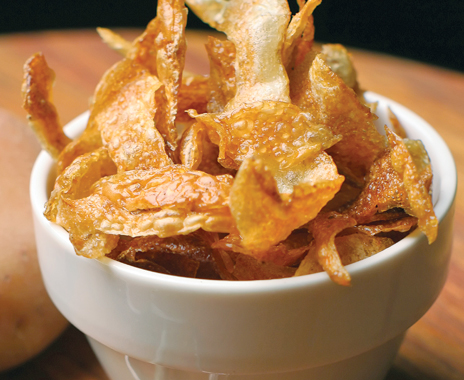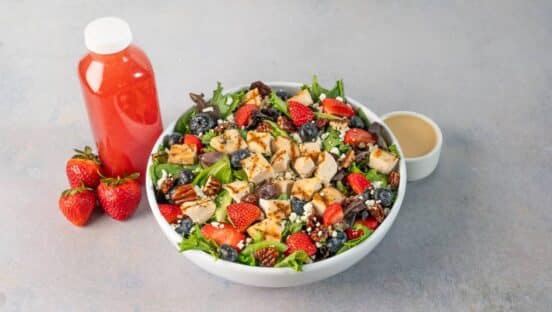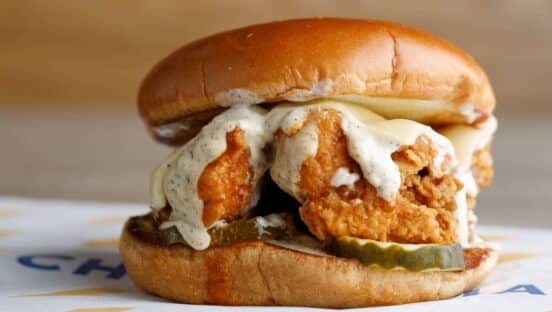Consider the spud. Sure, it’s often thought of as a simple, standard restaurant staple—and in the quick-service field often relegated to the side of the plate or presented in fried format—but it also can be the subject of inspiration and kitchen creativity. Potatoes are also a cost-effective comfort food open to culinary flair.
“Potatoes are among the best profit makers for restaurants,” says Susan Weller, global foodservice marketing manager at the U.S. Potato Board. “And there are so many options for potatoes on the menu.”
A look at limited-service restaurant menus finds all kinds of uses for tubers, not only in perennial favorite sides like fries, chips, and mashed potatoes, but also in soups, salads, and a variety of entrées, from loaded baked potatoes to burritos. Market research firm Datassential found that potatoes were on the menu at 72 percent of quick-service restaurants in 2014’s fourth quarter, down marginally from a year earlier.
“That’s really not a surprise,” says Claire Conaghan, project director at Datassential, of the slight decrease. “We see more and more restaurants having an ethnic focus that doesn’t include potatoes, and more of those are being added than the classic burger-and-fries places.”
More than 55 percent of limited-service operators offered at least one potato item as a side, while nearly as many had them as an entrée. Not surprisingly, fries—including sweet potato fries—are the most popular items, followed closely by potato chips. Both are offered by nearly half of quick-service restaurants. The next closest, but well behind, are cheese fries and sweet potatoes.
“Any growth in potatoes is coming from sweet potatoes and sweet potato fries,” Conaghan says. “Restaurants aren’t taking regular fries off the menu, but they’re adding sweet potatoes because they have a health halo and can provide something new.”
Sweet potato fry mentions on limited-service restaurant menus soared 146 percent from 2010 to 2014, Datassential statistics show.
“We have definitely seen a big increase,” says Laura Kornegay Hearn, marketing and business development director for Nash Produce, a sweet potato supplier in Nashville, North Carolina. “I get a lot more inquiries about ways to get sweet potatoes on menus.”
She adds that sweet potato growth is helped along by the fact that more consumers are interested in trying new foods, “plus people are always looking for healthy alternatives in quick service.”
White potato fries remain popular because they can be served so many ways—with skins on or off, baked or fried, and in shoestring, wedge, curly, waffle, and round shapes.
“A number of restaurants are giving people choices of sauces or dips, so they may serve two or three flavors of dips with an order of fries,” says Don Odiorne, vice president of foodservice for the Idaho Potato Commission. “It’s just like wings with various sauces.” That makes fries both customizable and shareable, two trends that are increasingly popular with Millennial consumers, he adds.
Idaho is the biggest potato producer, with 14.2 billion pounds produced in 2013, according to U.S. Department of Agriculture statistics. Idaho’s neighbor, Washington, is second at 9.2 billion pounds, while the next eight states combined total 17.2 billion pounds.
Chefs at limited-service restaurants are doing more these days to create great dishes with potatoes—even baked ones, Odiorne says. “It used to be places would bake potatoes ahead of time, keep them on a steam table, then open them up and put a pump of warm cheese sauce and steamed broccoli on them and call that good,” he says. “That wouldn’t fly today.”
Instead, baked potatoes today can be more like artisan pizzas, with a variety of fresh topping options and made to each customer’s design. “A loaded baked potato is a challenge to do at home, but it’s a perfect medium for fast casual,” Odiorne says.
At McAlister’s Deli, potatoes are a “significant part of our menu,” positioned to be both entrées and sides, says corporate executive chef David Groll. He estimates potato items are 12–14 percent of the chain’s volume.
“They’re a great comfort food and can be a great carrier that I compare with pizza or flatbread, in that you can use hundreds of ingredients on them,” Groll says.
McAlister’s has dedicated a whole menu category, Spuds, to the vegetable. The nine baked potato offerings range from one with just a side of sour cream to the popular Spud Max, which has ham, turkey, bacon, Cheddar Jack cheese, green onions, and black olives. Other Spuds have toppings such as chili, roast beef, grilled chicken, and pot roast. Potatoes are also part of the Choose Two menu, in which a guest can select a cup of soup with any half portion of starter, salad, sandwich, or potato.
“Potatoes are great because they have applications at both lunch and dinner,” Groll says. “People like them because they’re good for you—potassium, fiber, and more—and we can do a Choose Two with a potato that will be low in calories.”
McAlister’s potato sides include chips, mashed potatoes with gravy, and potato salad. The chain’s Country Potato Soup with bacon and Cheddar cheese is “like a loaded potato with scallions,” Groll says.
One take on loaded potatoes at some restaurants is poutine, a Canadian favorite that features french fries topped with gravy and cheese curds. “It’s really starting to take off,” Odiorne says, particularly in full service, although it’s on the menu at limited-service places like Big Smoke Burger.
Tubers play a major role at Denver-based Modmarket, in large part because they’re so versatile, says chef Nate Weir. “We get good results and consistent results in menu items that are easy to execute,” he says.
[pagebreak]
The chain uses baby red, fingerling, and sweet potatoes, “and every one is used in multiple ways,” Weir adds. They also can be part of vegetarian and gluten-free items.
Mashed sweet potatoes with rosemary is a side dish at Modmarket, but the potatoes are also shredded and roasted as part of the Thai Coconut salad, which includes mixed greens, roasted chicken, grated coconut, cucumber, and peanut-mango dressing. The red potatoes are smashed for a side dish and are part of several soups, while the fingerlings, which are usually purchased locally and come in a variety of colors, are roasted, cut up, and featured in the Flatiron and Wintergreen salads.
Modmarket’s breakfast menu includes a trio of Scrambles, each of which includes potatoes roasted in high heat to “provide a nice textural component,” Weir says.
Several newer limited-service concepts have made the potato the star of their menu, including Potatopia, 3 Potato 4, and French Fry Heaven.
The fast-casual, five-unit Potatopia has an assembly-line format and features both signature items and a build-your-own option. The concept is mostly located in malls in the New York City metro area.
“I always wanted a quick-service concept, but there were a million burger concepts and pizzerias,” says founder and president Allen Dikker. “I chose potatoes as the vehicle.”
Potatopia offers smashed redskin, baked white, and sweet potatoes, as well as skin chips, potato chips, and curly, shoestring, and sweet potato fries. These can be topped with a protein—bacon, steak, chicken, sausage, or shrimp—as well as a dozen vegetable and cheese options. Finally, there’s the sauce, ranging from chipotle ketchup to truffle or curry sauces.
“The No. 1 sellers are the redskins, which are roasted for an hour and then smashed,” Dikker says. “As we’ve gone along, we’ve upgraded the menu, doing fire-roasted corn and mushrooms, rather than just raw vegetables.”
At 3 Potato 4, all of the potatoes are baked.
“I was looking for a healthy option for people, but to do it in a way that was very low risk for potential franchisees,” says Guenevere Blanchard, chief executive, president, and founder of the company that has franchise units in California, Las Vegas, and New Orleans.
There are Russet, redskin, sweet potato, crinkle cut, curly, and a medley of purple Peruvian potato fries that come in paper cones, either small, medium, or large. Guests can choose from among nearly 50 sauces, including Aztec or curry ketchup, pineapple-habanero barbecue, or “razzberry” chipotle. There are also flavored sea salts.
Part of the company’s concept is to have a zero-carbon footprint. “We’re using the potato from start to finish,” Blanchard says. The paper in some cones is made from potato starch.
While most people don’t consider spuds a major part of the most popular ethnic cuisines, that’s not always the case. Del Taco, the 50-year-old, 550-unit Mexican-American chain based in Lake Forest, California, features tubers in a wide range of menu items.
“We started with tacos and burritos alongside burgers and fries, and that’s a legacy that stays with us,” says Anne Albertine, research and development director. “Potatoes in a burrito is really [California] style, as we do in our Epic Cali Steak and Guac Burrito.” The burrito includes grilled carne asada steak, guacamole, and crinkle-cut fries. Those fries are part of several other Epic and breakfast burritos, as well as the Chili Cheddar Fries and Carnitas Loaded Fries. Potatoes are also in the Cheddar Potato Poppers and Breakfast Hashbrown Sticks.
“Potato fries are such an American classic—crispy on the outside and moist on the inside, so they offer a great texture with a salty element,” Albertine says. “In our Epic burritos, they help provide a combination of taste and texture, smoothness and crunchiness.”
Although Mexican food is known for vegetables like corn, beans, and squash, “potatoes are traditional and original” in tinga (a traditional Mexican dish) or stews, Albertine adds.
The global nature of potatoes can be seen in the fact that the U.S. ranks only fifth in worldwide potato production. Tops is China, followed by India, which combined account for more than one-third of the world’s potato production.
“Asians use potatoes in many different forms,” says Weller of the U.S. Potato Board. “Things like potatoes and rice together in the same dish is no problem in Japan.” Potatoes are popular in many dishes or as a stand-alone roasted vegetable in northern China.
Spuds are key to Indian street food, says Meherwan Irani, owner and executive chef of Chai Pani Indian Street Food eateries in Asheville, North Carolina, and Decatur, Georgia.
“They’re not used so much in north Indian cooking—the style that’s best known in the United States—but most Indian street food heavily features potatoes, whether they’re pockets, fried, or mashed,” he says. “That’s why they’re on our menu.”
Chai Pani’s top three items feature potatoes, led by Bombay Chili Cheese Fries, in which masala fries are topped with lamb hash, Paneer, onions, cilantro, and a hot sauce drizzle and served with tomato chutney.
Another take on a ubiquitous Indian street food at Chai Pani is Vada Pav, which has spicy potato dumplings fried in curried chickpea batter. And samosas are a flaky pastry stuffed with spicy cumin-scented potatoes.
“We do mostly street snacks, small plates the same as tapas in Spain,” Irani says. “That way people can share and experience many different flavors.”











